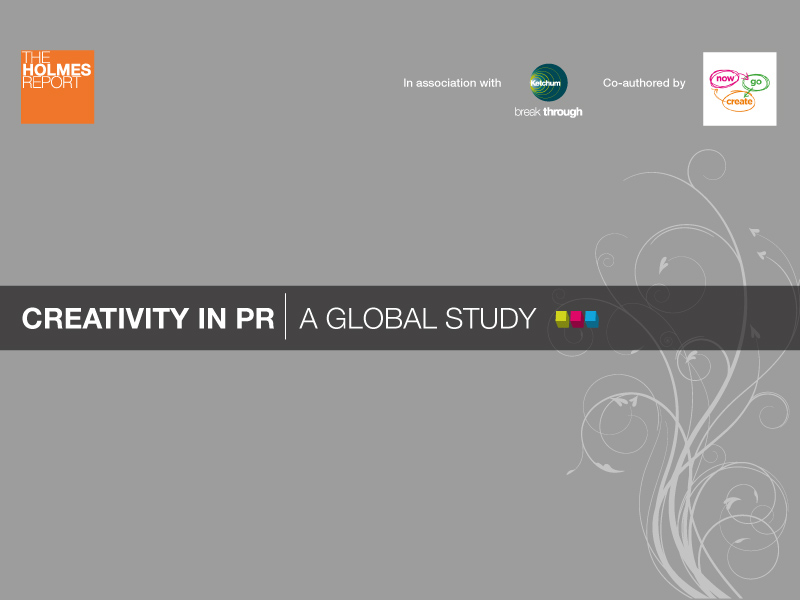Arun Sudhaman 15 Nov 2012 // 12:00AM GMT

NEW YORK--The Creativity In PR study reveals a gap between the aspirations of an industry that acknowledges creativity as a fundamental skill, and a business culture that does not deliver it consistently.
The Creativity in PR report is co-authored by the Holmes Report and NowGoCreate, in partnership with Ketchum, based on a survey of 650 PR people from more than 35 countries across the world.
The study forms part of the Holmes Report's new Creativity channel, which aims to celebrate, explore and analyse creativity in the public relations industry.
So far this week, we have examined the big idea deficit that apparently plagues PR, and the resourcing issues that are viewed as key barriers to a more creative industry .
Today, the Holmes Report looks at the findings relating to working practices in the industry and the critical talent equation.
Importance vs Involvement
Asked to rate the importance of creativity in their day-to-day work out of 10, almost a third of respondents opted for full marks, and around two-thirds said 8 or higher.
This reinforces the finding revealed earlier this week, acknowledging creativity as a fundamental skill (95 percent), with most respondents considering themselves creative (89 percent).
However, almost half of all respondents replied that creativity is only involved in half of their day-to-day work or less - which perhaps helps to explain the gap between the perception of creativity, and the reality of its day-today impact on the profession.
These results, say co-author and NowGoCreate founder Claire Bridges, suggest "a lack of adoption of working practices to deliver creativity consistently."
"Our report shows a huge contradiction and an inability to break out of a head-down, production line mentality with businesses unwilling or unable to do what's needed to support creativity," adds Bridges. "Are there any other areas considered business critical where the outcomes are left to chance? 50 percent of organisations have no clear creative objectives, 42 percent don’t reward creativity at all and three out of 10 have no process in place."
“It's fashionable to say that creativity is important, but far harder to actually perform creatively," explains Ketchum chief innovation officer Karen Strauss. "We need to find ways to remove mindless, routinized tasks from our days so we're all spending more hours gaining the creative inspiration to conceive novel ideas and do break through work.”
Where do ideas come from?
The study explored the processes and practices that are in place to help develop the ideas that deliver outstanding campaigns, influence behaviour, generate content and grab media headlines.
71 percent say they have a creative process in their business. When it comes to idea generation, group brainstorming is the default. At 86 percent it’s by far the most popular method of generating ideas.
Whilst, anecdotally, agencies referred to their own internal processes, there is a heavy reliance on a technique devised in the 1950s and technology is notable by its absence.
After brainstorming, using case studies, mentoring and insight are the top three initiatives cited to support creativity. 11 percent say nothing is done, it’s just part of the job.
When asked how ideas are assessed, the most popular response was 'personal experience.' Indeed, many of the methods used are subjective - indicating an opportunity for the industry if evaluation can be made more robust.
Talent and rewards
Should PR firms or departments have a creative director? Our respondents tend to think not, with
the majority noting that the position is not necessary, as it is part of everyone’s job. Just under a third already have this role in place, with another 13 percent considering it.
“Culture change is crucial to driving creativity," said one respondent from a global agency. "Creativity drive must permeate the organisation from hiring, leadership, training, rewards, showcasing
etc. It's not one person's job - a creative director is not the answer to educating 1000 staff on creativity.”
Meanwhile, 42 percent of respondents do not reward or incentivise creativity, with around the same proportion opting for internal rewards.
"To overcome these constraints, and develop an appropriate climate in which creativity can flourish, the industry will need to address not only the issues around recruitment, training and incentivisation, but also to look to new opportunities such as those arising from recent developments in technology," says Dr Sara Jones, MA programme director in Creativity & Leadership at City University London.
"Social media, crowd-sourcing, serious games, affective computing and the use of big data visualisations all offer an abundance of exciting opportunities that are there for the taking."


































.jpg)






























